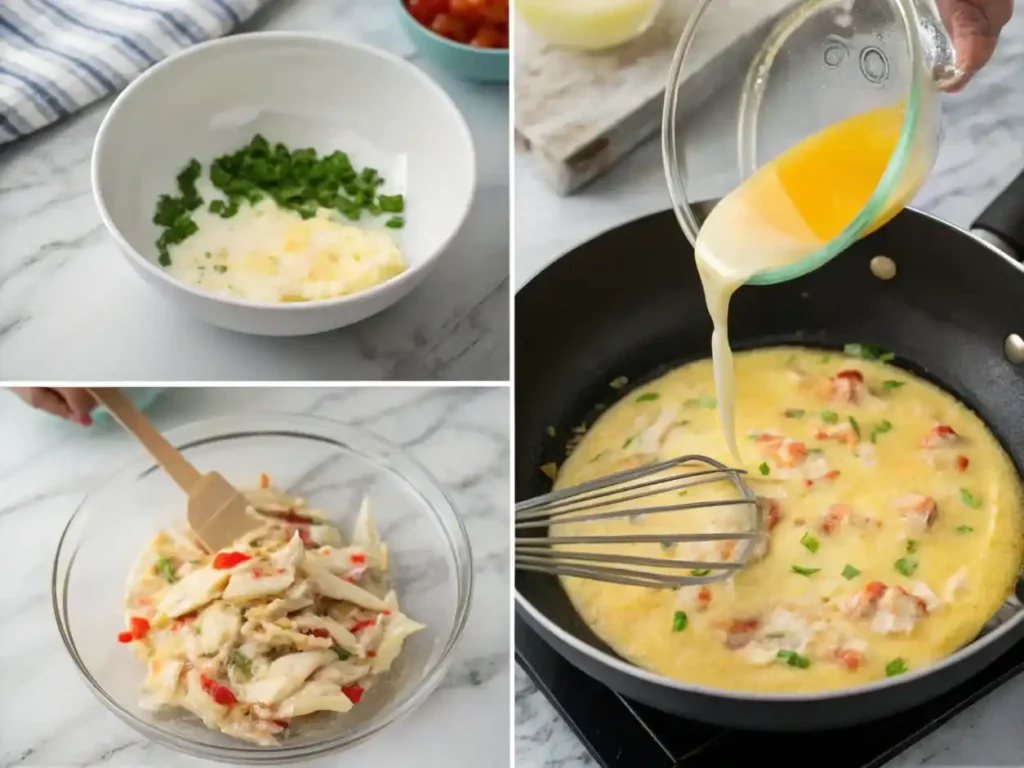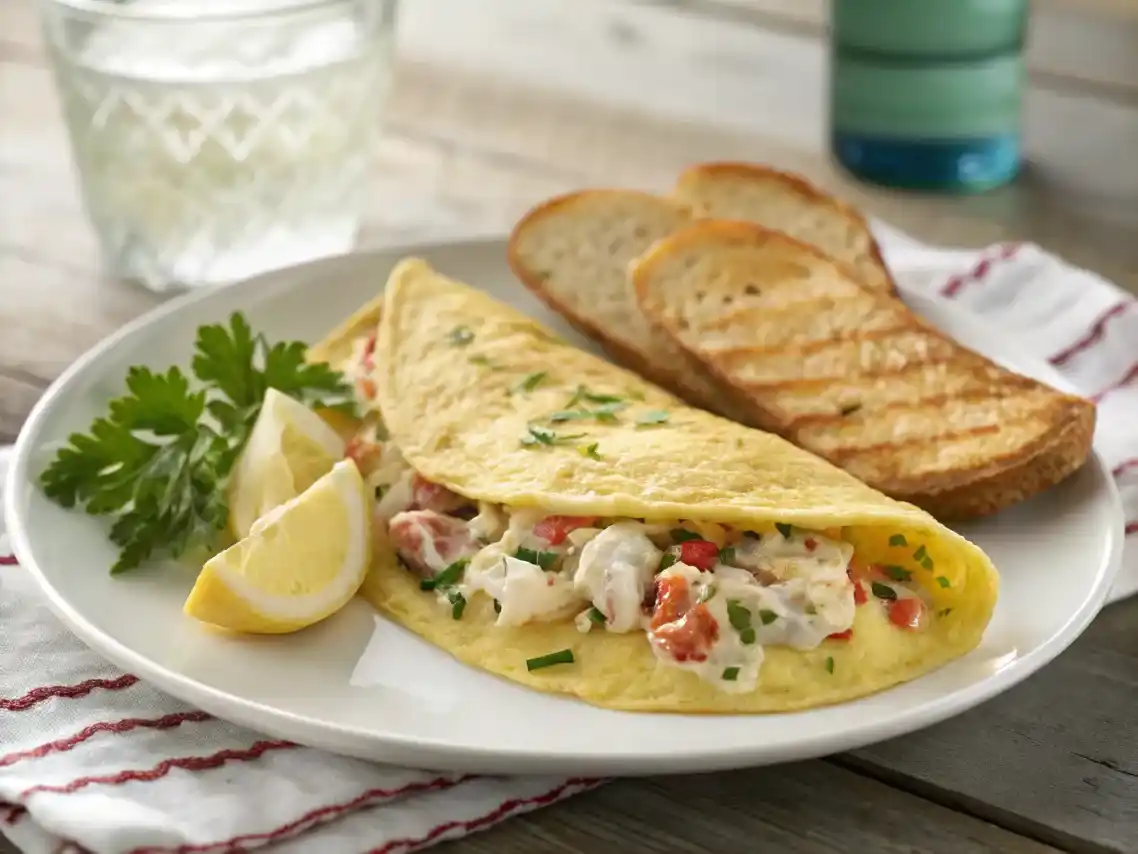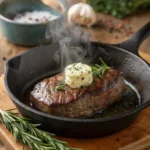Few breakfast dishes feel as indulgent yet effortless as a fluffy crab omelette bursting with tender crab meat. This guide explains every step—from choosing crustaceans to mastering the flip—so you can serve a restaurant-worthy plate at home. Expect clear technique, ingredient science, and flavor twists you can trust. If you crave quick seafood elegance that still fits a relaxed weekend vibe, keep reading.
Table of Contents
What Makes a Crab Omelette Unforgettable?
A perfect omelette is silk on a fork, but add tender crab and the dish becomes celebration-worthy. The gentle sweetness of sweet crabmeat contrasts with savory eggs, while delicate flakes supply a luxurious mouthfeel without the heft of fried crab cakes. When you fold the sheet over the filling, tidy layers trap steam and concentrate flavor.
Although preparation takes barely 3 minutes, the result tastes as if you spent hours at the stove. The protein, omega-3s, and minerals in crab make the plate nourishing as well as decadent—proof that comfort food and wellness can share the same serving plate.
Which Crab Is Best—Fresh, Lump, or Canned?
Nothing matches fresh crab meat pulled from the shell moments before cooking; Pacific dungeness crab tastes mildly briny, while Atlantic lump crab meat supplies photogenic chunks that stay intact. When convenience rules, high-quality canned crab (well-drained) delivers solid flavor fast. Experienced diners swear that just-harvested flavor beats frozen every time.
Blot excess moisture before cooking so the omelette stays lofty. Store surplus in a chilled box: tomorrow’s pasta or salad will thank you. Zero waste is easy when leftover crab becomes tomorrow’s treat.
Equipment Essentials: Do You Need a Specialized Pan?
A modern non-stick skillet virtually guarantees success. Its slick surface lets fragile curds slide free. If you own an omelette pan with curved sides, bonus—geometry makes rolling effortless. Pre-heat over high heat for thirty seconds, then drop to medium heat; the temperature shift sets the eggs without browning.
Tool number two is your rubber spatula. Its flexible edge protects tender curds during that crucial moment when you fold the omelet in half. A slender balloon whisk rounds out the roster, aerating the eggs for lift.
Tip: Keep a rubber spatula handy; the right tool can be the difference between a perfect roll and a ragged heap.
Ingredients & Mise en Place for a Stellar Crab Omelet

- 4 large eggs
- ½ cup crabmeat (fresh, lump, or well-drained canned)
- 1 Tbsp minced green onions
- 1 tsp chopped parsley
- Splash of lemon juice
- 2 Tbsp milk (whole, low-fat, or preferred dairy-free option)
- Pinch of salt
- Grind of salt and pepper
- Dusting of Old Bay seasoning
- 1 Tbsp neutral oil (canola, grapeseed, or similar)
- 1 Tbsp butter
- ¼ cup shredded parmesan cheese
- 1 Tbsp minced chive
Preparation Snapshot
- Create the crab mixture – In a small bowl, combine crabmeat, green onions, parsley, and lemon juice; set aside.
- Beat the eggs – Whisk eggs with milk until the egg mixture is completely uniform—no liquid streaks. Season with salt, pepper, and Old Bay.
- Sauté aromatics – Warm oil and butter in a non-stick skillet over medium heat; sauté green onions for 60 seconds, then add the crab mixture just to heat through.
- Finish the filling – Remove pan from heat; stir in shredded parmesan and minced chive. The dairy melts into the shellfish, adding richness without overpowering.
Step-by-Step Method: The Only Ocean Fare Omelette Method You Need

- Pour & Swirl – Eggs hit the hot pan and spread. Stir gently with the turner until curds form.
- Fill & Roll – Scatter the warm filling over one side, then use your wrist to roll.
- Finish & Slide – Tilt the pan so gravity eases the crescent onto the plate.
Because the center contains already cooked crab, warming suffices. A final sprinkle of grated parmesan and a squeeze of lemon add contrast, while chopped fresh herbs make a vibrant garnish.
Looking for a classic crab omelet recipe? Follow the same steps but add a spoon of crème fraîche to the filling. Readers who just want a base omelet recipe can omit the shellfish and double the herbs.
Troubleshooting: Why Did My Crab Omelet Tear or Weep?
If the sheet sticks, heat or fat was off. Wipe, re-grease, and try again. Liquid pooling? Drain crab meat thoroughly. Humid kitchens or thin pans can sabotage texture—invest in reliable non-stick surfaces.
Advanced Technique: Temperature Curves
Home burners cycle on and off. Slide the pan halfway off the flame after the initial swirl to even heat. Aim for 250 °F surface temperature. Should a brown halo form, tuck that edge inside during the final roll.
Knife & Fork Etiquette
A table knife tears delicate layers; suggest diners use the fork edge or a spoon. For canapé service, slice the roll into one-inch coins while warm, then spear each with a pick—fewer carpet stains at parties.
Kids in the Kitchen
Let young cooks tear herbs or set the table. Older children can whisk, learning how foam forms as coils trap air—science disguised as fun family time.
Serving & Pairing Ideas for an Elevated Seafood Midday Feast
Arugula salad dressed in citrus-kissed vinaigrette and crusty bread turn this crab omelet into bistro fare. For dinner, slice and stack over risotto; creamy rice meets tender shellfish in harmony.
Ideal Serving Temperature: 140 °F—warm enough for aromas to bloom yet cool enough to avoid steam burns.
Pro presentation trick: make a crab silhouette from roasted pepper strips and perch it on the omelette’s edge—its color hints at the naturally sweet crabmeat tucked inside.
Kitchen Notes, Variations, and Storage Tips
These recipe notes guarantee zero waste:
- Swap dill or cilantro for parsley; both love seafood.
- Use coconut milk for tropical flair.
- Roll roasted peppers into the eggs for color.
- Chill spare filling for quick tacos tomorrow.
Refrigerate the roll up to a day; reheat gently. Never freeze—the thaw turns grainy.
Chef’s Q&A: Taking the Dish Further
How can I flavor eggs without overshadowing the filling?
Use garlic-infused oil or smoked-paprika butter sparingly; potent fat means fewer spices.
Feeding a crowd?
Hold seasoned eggs in a pitcher, filling warm in a bain-marie. Cook a round every two minutes; keep portions warm in a 200 °F oven.
Dairy-free ideas?
Coconut oil plus toasted crumbs replaces butter and cheese.
Historical roots?
Nineteenth-century French rail buffets served lobster-stuffed omelettes; Asian stalls still sell oyster versions. Today’s plate stands on tall culinary shoulders.

Crab Omelette Recipe: Surprisingly Delicious Magic
Ingredients
4 large eggs
- ½ cup crabmeat fresh, lump, or well-drained canned
1 Tbsp minced green onions
- 1 tsp chopped parsley
Splash of lemon juice
- 2 Tbsp milk whole, low-fat, or preferred dairy-free option
Pinch of salt
- Grind of salt and pepper
Dusting of Old Bay seasoning
- 1 Tbsp neutral oil canola, grapeseed, or similar
1 Tbsp butter
- ¼ cup shredded parmesan cheese
1 Tbsp minced chive
Instructions
Create the crab mixture – In a small bowl, combine crabmeat, green onions, parsley, and lemon juice; set aside.
- Beat the eggs – Whisk eggs with milk until the egg mixture is completely uniform—no liquid streaks. Season with salt, pepper, and Old Bay.
Sauté aromatics – Warm oil and butter in a non-stick skillet over medium heat; sauté green onions for 60 seconds, then add the crab mixture just to heat through.
- Finish the filling – Remove pan from heat; stir in shredded parmesan and minced chive. The dairy melts into the shellfish, adding richness without overpowering.
Notes
Nutrition Information (Per Serving)
| Nutrient | Amount |
|---|---|
| Calories | 280 kcal |
| Protein | 22 g |
| Fat | 18 g |
| Carbohydrates | 3 g |
| Cholesterol | 225 mg |
| Sodium | 430 mg |
| Fiber | 0.5 g |
| Sugar | 1 g |
📂 Recipe Categories
- Course: Breakfast, Brunch
- Cuisine: French-Inspired, Coastal
- Diet: Pescatarian, Low-Carb
- Method: Pan-Fried, Stovetop
- Keyword: Crab Omelette, Seafood Brunch, Easy Omelette, Lump Crab, Egg Dishes
- Skill Level: Beginner to Intermediate











